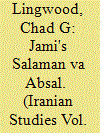|
|
|
Sort Order |
|
|
|
Items / Page
|
|
|
|
|
|
|
| Srl | Item |
| 1 |
ID:
168982


|
|
|
|
|
| Summary/Abstract |
This article presents two hitherto unstudied compilations of verses from the Bustān of Saʿdī. Both circulated in the Persianate world in the fifteenth and sixteenth centuries. The article provides an analysis of the compilations’ content as well as their relation to the complete Bustān. By highlighting certain stories and themes at the expense of others, and by ordering these passages in a way that differs from the complete Bustān, each compilation transforms Saʿdī’s text into a shorter, more homogenous composition, with distinct formal, thematic, and generic qualities. The shorter compilation presents a series of aphorisms, forming a mirror for princes. The longer one offers a selection of stories and lessons and emphasizes mystical themes, including aspects of Sufi erotic theology. This article also investigates the manuscript copies of these compilations, revealing their use and transmission in Iran, Turkey, and Central Asia between 1470 and 1550.
|
|
|
|
|
|
|
|
|
|
|
|
|
|
|
|
| 2 |
ID:
102704


|
|
|
|
|
| Publication |
2011.
|
| Summary/Abstract |
This article explores Salaman va Absal , one of seven poems which comprise Jami's collection of long masnavis, known collectively as the Haft aurang. The work, which gained some renown outside Iran due to the English version of Edward FitzGerald, has nevertheless received little attention in modern scholarship. The few investigations of Salaman va Absal moreover, have dwelled on its narrative, which tells the story of the carnal attraction of a prince for his wet-nurse, and never situated the work in its historical context or examined its political content. In addition, the allegorical symbolism of the tale, especially its depiction of key stages of the Sufi path, such as the act of repentance, has not been discussed in terms of representing a work of mystical advice. With these concerns in mind, the present article discusses the possibility that the political elements in Salaman va Absal, complement the advice it gives on becoming a Sufi. Seen from this perspective, it would appear that Salaman va Absal correlates the notion of the just ruler to the Sufi concept of the "Perfect Man" to the extent that Jami's presents the Sufi-king as the ideal medieval Islamic ruler. By implication, the work advises its royal patron, Sultan Yaqub, to repent and embark upon the Sufi path, doing so, Jami intimates, would lead Ya'qub to realize his rank as God's "true" vicegerent.
|
|
|
|
|
|
|
|
|
|
|
|
|
|
|
|
|
|
|
|
|